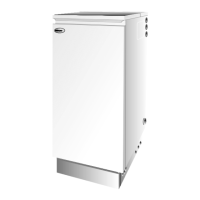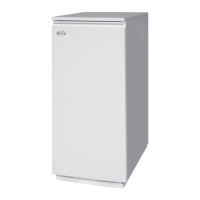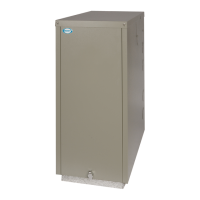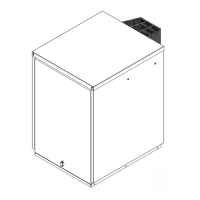Do you have a question about the Grant EUROFLAME 90/120 and is the answer not in the manual?
Provides an overview of the boiler's function and automatic operation for domestic hot water and central heating.
Details how to access and identify the control panel features for different boiler models.
Step-by-step guide on how to safely start and light the boiler, including pre-ignition checks.
Instructions for safely turning off the boiler for short or long periods, for different model types.
A checklist of common issues and steps to take when the boiler's burner fails to ignite.
Details the types of fuel (Kerosene or Gas Oil) suitable for the boiler and important considerations for fuel supply.
Explains key components like the boiler thermostat, lock-out reset, and safety thermostat for system maintenance.
Specifies the required voltage, frequency, fuse rating, and earthing for the boiler's electrical connection.
Explains how to manage pressure, air vents, and safety valves in a sealed heating system installation.
Presents detailed specifications including water content, weight, heat input, connections, and operating limits.
Provides performance data, efficiency, heat input, and settings for boilers using Class C2 Kerosene.
Offers performance data, efficiency, heat input, and settings for boilers using Class D Gas Oil.
Illustrates the physical dimensions and connection points for the 50/70 Utility and Boiler House models.
Shows physical dimensions and connection points for 70/90, 90/120 Kitchen/Utility, Boiler House, and System models.
Introduces the Euroflame range, model variants, fuel compatibility, flue types, and control panel features.
Lists essential building regulations, British Standards, and OFTEC requirements for boiler installation.
Details how different boiler models and flue kits are packaged and supplied in multiple cartons.
Covers fuel storage, pipe types, single/two-pipe systems, and the Tiger Loop system for oil delivery.
Specifies the required voltage, frequency, fuse rating, and earthing for the boiler's electrical connection.
Details the need for adequate air for combustion, ventilation, and draught stabilization.
Provides guidelines on the installation, materials, and positioning of conventional flue systems for optimal performance.
Step-by-step instructions for connecting the conventional flue to Kitchen/Utility and Boiler House models.
Describes available balanced flue kits, extensions, and their suitability for different boiler models and wall thicknesses.
Recommendations for installing frost thermostats to protect the system and boiler during cold weather.
Specifies requirements for firm, level installation surfaces and necessary clearances around the boiler.
Details the types of water connections, pipe sizes, and fitting procedures for various models.
Illustrates different heating system configurations, including gravity domestic hot water systems.
Diagrams and information for fully pumped heating system configurations.
Details requirements and components for sealed heating systems, including expansion vessels and pressure settings.
Essential requirements for pre-heating return water in underfloor systems to prevent boiler damage.
Instructions for safely removing the boiler and its components from the packaging.
Guidance on determining boiler position and making wall openings for balanced flue installations.
Instructions for fitting high level and vertical balanced flues, including adjustable sections, extensions, and bends.
Step-by-step guide on how to attach the burner to the boiler for Boiler House models.
Instructions for connecting the boiler's electrical supply to the mains, including wiring details.
Details on connecting the fuel supply lines to the boiler, including adaptor requirements.
Procedures for filling and venting sealed heating systems, checking expansion vessel pressure, and system integrity.
Outlines the essential steps and checks required for safe and efficient boiler commissioning.
Verifies system venting, pressure, fuel valve status, and burner component checks prior to startup.
Details the process of starting the boiler, managing the burner fan, and using the lock-out reset button.
Monitoring fuel pressure, checking for leaks, and ensuring correct burner operation at temperature.
Measuring CO₂, flue gas temperature, and smoke number, adjusting air damper for optimal settings.
Balancing radiators, checking for leaks, adding inhibitor, and performing final system checks.
Key information for users on boiler operation, frost precautions, servicing importance, and fuel type.
Emphasizes that servicing must be by qualified engineers and ensures user understanding of controls and system pressure.
Important initial checks before commencing boiler servicing, including flue, controls, and system integrity.
Procedures for safely dismantling boiler components, such as front panels and flexible air tubes, for servicing access.
Instructions for removing the burner and top insulation panel, with notes on fuel line connections.
Detailed steps for removing and cleaning baffles, internal surfaces, and checking seals for optimal performance.
Detailed instructions for cleaning the combustion head, electrodes, nozzle, photocell, fan, and pump filter.
Provides the control panel wiring diagram for Kitchen/Utility models, detailing connections and colour codes.
Presents the control panel wiring diagram for System boilers, showing connections for pump and thermostats.
Illustrates the wiring diagram for dual thermostats used in Boiler House models.
Shows wiring for Kitchen/Utility models using Honeywell S Plan with zone valves for HW & CH.
Wiring diagram for Boiler House models with Honeywell Y Plan, controlling HW via a mid-position valve.
Wiring diagram for System boilers using Honeywell S Plan for HW & CH control with zone valves.
Wiring diagram for system boilers with Honeywell Y Plan, controlling HW via a mid-position valve.
A step-by-step diagnostic flowchart to identify and resolve issues with the Riello RDB burner.
Lists common boiler faults, such as no start, lock-out, smoke, or low temperature, with corresponding remedies.
An illustrated breakdown of the Riello RDB burner with a list of spare parts and their corresponding numbers.
Details hazards, precautions, and first aid for insulation materials, sealants, and mineral oil fuels used in the product.
States the boiler's compliance with relevant European Directives, including EMC, electrical safety, and efficiency.
| Fuel Type | Oil |
|---|---|
| Efficiency | 90% |
| Installation Type | Floor Standing |
| Flue Type | Conventional Flue |
| Boiler Type | Condensing |
| Heat Exchanger Material | Stainless Steel |
| Warranty | 2 Years |
| Output | 90 - 120 kW |






